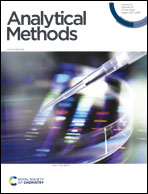ELISA as an effective tool to determine spatial and seasonal occurrence of emerging contaminants in the aquatic environment†
Abstract
During the last two decades, studies related to the occurrence and fate of emerging contaminants in the aquatic environment have received great attention from the international scientific community. The monitoring of the presence of these compounds is particularly important since they are known to induce adverse effects in aquatic environments, even at extremely low concentrations. This work aimed to apply a simple and effective methodology, such as enzyme-linked immunosorbent assay (ELISA), in the monitoring of 17α-ethinylestradiol (EE2) and 17β-estradiol (E2) (a synthetic and a natural hormone, respectively), carbamazepine (CBZ, an antiepileptic), cetirizine (CET, an antihistamine) and caffeine (CAF, a stimulant) in water matrices with differing salinity and organic matter contents. ELISA was proven to be a valid and practical tool, especially for screening purposes in contrast to traditional chromatographic techniques which are prohibitively expensive for an application on a broader base. The main originality of this work was to establish seasonal and spatial effects on the occurrence of the referred contaminants by using the effectiveness of ELISA to screen those compounds in samples with different characteristics. This work reports both the seasonal and spatial quantification of the referred contaminants in the aquatic environment of the central region of Portugal, with concentrations ranging as follows: 5–87 ng L−1, for E2, 2–17 ng L−1, for EE2, 10–1290 ng L−1, for CBZ, 10–190 ng L−1, for CET, and 62–6400 ng L−1, for CAF.



 Please wait while we load your content...
Please wait while we load your content...